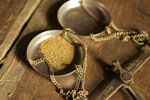
A powerful segment on CBS’ 60 Minutes last night demonstrated with stark clarity how the trade in conflict gold is a major source of funding for armed groups that target civilian populations in the Democratic Republic of the Congo. Gold also plays a key role in electronic devices, making up two-thirds of value of the metals inside cell phones and personal computers. A jewelry industry spokesperson interviewed for the show seemed genuinely perplexed about how to ensure that gold does not finance the conflict in eastern Congo. Yet the supply chain in gold can be made conflict-free through the same three steps that Enough has recommended for other conflict minerals:
1) Trace: Companies must determine the precise sources of their minerals.
2) Audit: Companies should conduct detailed examinations of their mineral supply chains. Credible third parties should conduct and/or verify these audits.
3) Certify: In order for consumers to be able to purchase conflict-free electronics and jewelry made with Congolese minerals, a certification scheme that builds upon the lessons of the Kimberley Process will be required.
The gold trade differs from that of other minerals in several important ways:
• Gold is much more valuable by weight compared with other minerals. As a result, it is easier to smuggle small amounts of gold that are valuable.
• Gold is easier to refine than the other minerals and can be smelted into metal earlier in the supply chain, making it more difficult to trace.
• Because of gold’s importance as a store of value in the international financial system, legislative efforts to curb the import of gold into the United States are more complicated than in the case of other minerals.
These complications do not mean that that a transparent supply chain is impossible, but consumers will have to generate sufficient pressure on the industry to take the necessary action. Because more than 80 percent of gold in the United States is used in jewelry, and nine percent of worldwide gold is used in electronics, concerted consumer action has enormous potential to clean up these supply chains.
How does U.S. legislation address Congo’s gold trade?
Gold is cited as a source of financing for armed groups in eastern Congo in both the Senate (S.891) and House (H.R. 4128) versions of legislation on conflict minerals. But because of the complicating factors described above, gold has not been included in the sections of the legislation that mandate more traceable and transparent supply chains. However other critical aspects of legislation, including a U.S. government strategy to address this issue, the mapping of militarized mining sites, and ensuring that State Department human rights reports cover the issues related to the trade in conflict minerals, do incorporate coverage of the gold trade.
Can I buy conflict-free jewelry?
The No Dirty Gold campaign is an effort to end destructive impacts of gold mining, including the sourcing of gold from conflict areas, such as eastern Congo. A list of retailers that have signed on to support their 10 Golden rules is available here.
Tiffany & Co.: According to their website: “The majority of the gold and silver used in Tiffany & Co. jewelry workshops is obtained from a single U.S. mine that meets high
standards of social and environmental responsibility.”
Wal-Mart: Wal-Mart’s Love Earth jewelry line is a completely traceable line of jewelry that allows consumers to trace the supply chain for their jewelry online, back to specific mines of origin. However this is only one line of products, and Wal-Mart’s current target is to make 10 percent of its diamonds, gold, and silver traceable by 2010.
Fair Trade Gold: The Alliance for Responsible Mining, or ARM, has pioneered a set of standards for fair trade artisanal gold. For more on this effort, visit their website.
Photo: Miners bring gold powder to gold dealerships, where it is weighed and tested. (Grassroots Reconciliation Group/Sasha Lezhnev)

